When I was in Maine last week attending a memorial service I noticed some roses were still blooming. Night time temperatures were dipping into the up 30’s and windshields frost-covered in the morning. Still the roses were putting on new blossoms and quite a few other species were still producing, staghorn sumac among them.
Rose hips are high in vitamin C and can vary in flavor from bitter to Sweet & Sour. Raw you eat only the outside portion, avoiding the seeds. The seeds have tiny hair on them that are very irritating. They were the original itching powder and if consumed can cause what the Aboriginals called “itchy bottom disease.” You can cut the hips in half — if they are large — and let them dry then use the outside to make tea. Or you can use the entire rose hip for tea but pour it through a fine filter to take out the hairs. Another option is to boil the hip then squeeze the pulp through a screen or the like, capturing the seeds. Some people dry the hips and rub them in a sieve to get the hairs off leaving the seeds — it takes patience. I would expect the rose seeds to have a small amount of cyanide in them — most plants in that family do — but I have not found any serious research on that. Besides the hips rose petals are also edible. The size of rose hips vary as does their persistence to stay on during the winter. To read more about roses go here.
Foraging is a broad topic. Some folks are interested in the utility side: Edible, not edible. Others view the foraged plant as part of a larger dynamic, not only the local environment but the Grand Environment at large. And there are folks for whom foraging has a spiritual side. Along those latter lines is The Wild Wisdom of Weeds, Thirteen Essential Plants for Human Survival by Katrina Blair, ISBN 978-1-60358-516-3, Chelsea Green Publishing, White River Junction, Vermont, published in September.
Writing about wild edibles is much like teaching about them. You are faced with a choice: Say a little about a lot of plants or say a lot about a few plants. Neither is right or wrong but it is a choice writers and teachers have to make. In this book Blair has chosen to write extensively about 13 different plants. They were selected because they live in close company to people, are environmentally adaptable group, and usually available fresh. The menu is: Amaranth, chickweed, clover, dandelion, dock, grass, knotweed, lambsquarters, mallow, mustard, plantain, purslane, and thistle.
While all of these global species have been used as food and medicine there is more to it. Blair considers harvesting wild food a “core living skill” with added benefits: “The wild weeds offer a direct link for accessing wild intelligence within each of us. As humans are becoming increasingly distant from daily access to the wilderness, the wild weeds bring a quality of integrity and healing frequencies into our civilized habitats. Over millennia, they have fine-tuned their equilibrium with the changing seasons of nature, increasing their instinctive nature to survive.” For Blair the collection is both metaphysical and numerical and she chose 13 species for a variety of reasons.
One area where Blair might irritate a few readers — particularly native plant society folks — is an unkindly view towards those who call species “invasive.” Indeed, what is native, non-native and invasive? Her writing echoes some research regarding biodiversity and “invasives.” For example in North America most of the invasives are from Asia yet Asia has a few invasives from North America. The argument goes that Asia has more invasive species because it has greater biodiversity. Some are suggesting greater biodiversity is more significant that if a particular plant is invasive or not.
As to practical matters Blair offers much information on harvesting, preparing, eating and preserving your foraged food. She also argues they are good for the local economy, for our health and food security, and are an independent source of medicine that is in tune with our nature. With nearly a year’s worth of pages (358) Blair offers a lot of experience and value in a book that sure to be a plant “Bible” and reference for many.
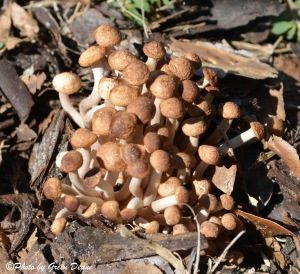
Honey Mushrooms are six weeks early, will our winter green plants be early, too? Photo by Green Deane
While in Maine I happened to wander around an 80-acre hay field, which when I was a boy was a blueberry field. Still available for harvesting was plantains, clover and blossoming sow thistles. Their last gasp before the snow flies is a reminder that here in The South many of us are coming into one of our prime foraging seasons. Many species of summer and fall up north show up here in the winter time. It is too hot for them in the summer so the debut after fall sets in. Prime among them will be sow thistles, dandelions, chickweed and mustard. Though our nights have been dipping into the 60’s F we are a month or more away from many of these species. Well, that would be the normal answer. But at least one edible that shows up around the second week of november here was six weeks early, Honey Mushrooms. So the foraging season for green plants might be off as well.
Upcoming Classes: Saturday, October 25th, Bayshore Live Oak Park, 23000 Bayshore Rd., Port Charlotte, FL 33980, 9 a.m.
Thursday, October 30th, Emerson Point Preserve, 5801 17th Street West, Palmetto, FL 34221. This class is part benefits Eat Local Week of greater Sarasota. The shortened class starts at 9 a.m. and goes to 11 a.m., cost is less than usual, $20. Because governmental agencies are involved the class has to be paid ahead of time. To learn more about other events of that week or to pay for this class go here. (The class link is near the bottom under EatTheWeeds class.)
Eat The Weeds On DVD. My foraging videos do not include alligators but they do cover dozens of edible plants in North America. The set has nine DVD. Each DVD has 15 videos for 135 in all. Some of these videos are of better quality than my free ones on the Internet. They are the same videos but many people like to have their own copy. I burn and compile the sets myself so if you have any issues I handle it. There are no middle foragers. And I’m working on adding a tenth DVD. To learn more about the DVDs or to order them click here.
On the Green Deane Forum we post messages and pictures about foraging all year-long. There’s also a UFO page, for Unidentified Flowering Objects so plants can be identified. Recent topics include: Grinder for Tough Roots, Atlatl, European Mountain Ash Edible? Curly Dock, Goldenrod of Some Sort, Saffron Crocus Surprise, Cute Little Orange Thing, Indian Strawberry and Kousa Dogwood, Top Ten Herbs, Paleo Goodies, American Beautyberry, Two Portulacas, Herbalist Question, Another Blue Berry, The Trails Are Getting Longer, Hard Apple Cider, and Pawpaws. The link to join is on the right hand side of this page.
If you would like to donate to Eat The Weeds please click here

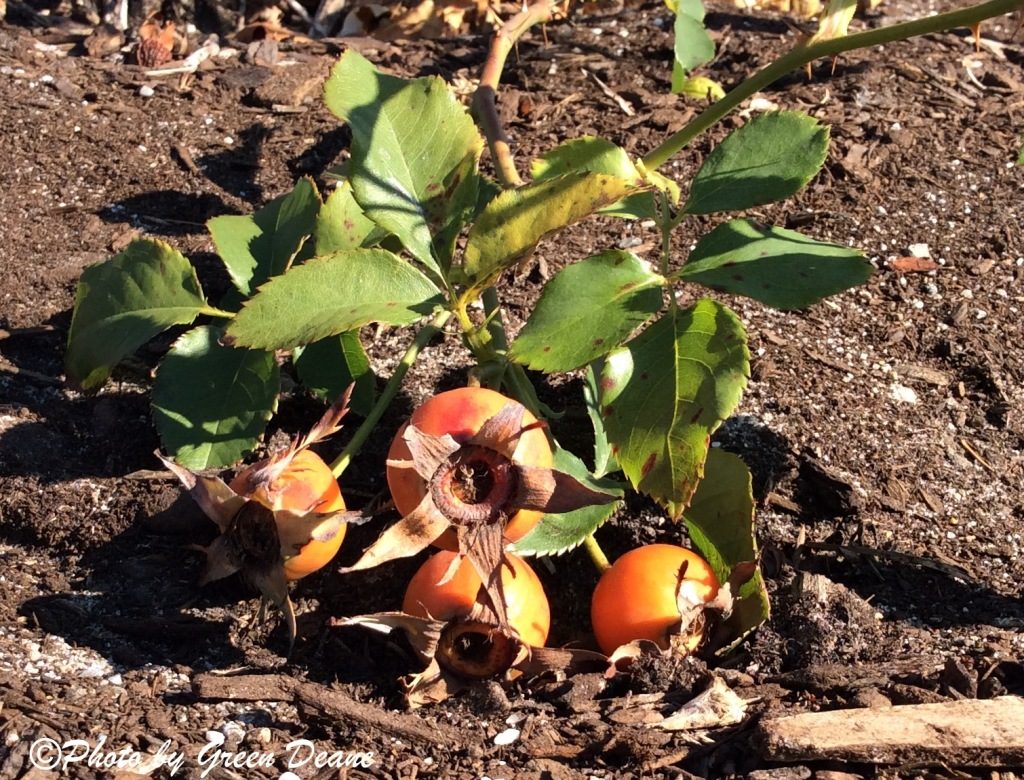
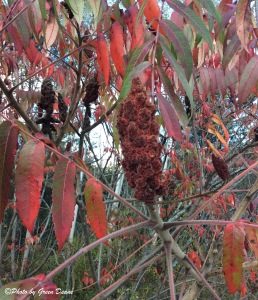
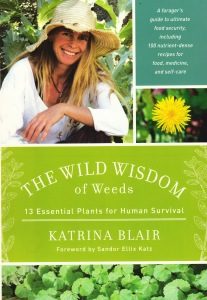
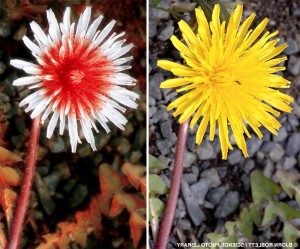




Hi Deane,
I wish you’d had a class when you were visiting New England! I’m not in Maine but would have gladly driven to find you. Thanks for all your important and well written information, I consider foraging a new passion and would like to see a review sometime on a plant I’ve recently discovered locally known as ‘Autumn Olive’ or Silverberry. It’s high in lycopene and deliciously sweet, but in my state it’s considered invasive. It shouldn’t be because it also affixes nitrogen to the soil thus is good for hillsides or wherever needed to prevent erosion. Thanks again!
Thank you, for the newsletter “Eat the weeds. A long time ago I was visiting my Son’s house & came across a book about identifying weeds along roadsides etc. I read it & have always remembered it, Having been a longtime interest in alternative medicine, helping folks with all the simple remedies that can make such a difference in a person’s health, I raised 5 son’s as natural as I could afford, & I am so blessed now as all my Son’s have adopted healthy eating habits on their own. In fact 2 of my Son’s are opening their own,Gluten free, healthy dishes/grain fed meats/restaurant in 2 weeks. As soon as I’m able I would like to obtain your information on your edible/survival weeds, in this unsurring world of ours.
Thank you for your interest in this wonderful endeavor of yours and look forward to knowing more about it.
Sincerely,
Joy
Would you consider doing an article about the edibility of pods from leguminous trees? Here in the southwest we have native Acacias, Mesquite and Paloverde trees–Locust and an Asian ornamental of the genus Albizia. Also, are the pods of ANY legume trees dangerous or toxic?
Was on the last Dreher Park foraging trip with you…. my third. Tall skinny retired surgeon.
AND…. once again, I request you put out a book. Why not just make it simple …. a compendium of all your articles. Simple… hire a book designer… and let them do all the work.
Consider that if (when) the SHTF, DVD players will be scarce indeed. Books won’t. Your book could save the lives of those who will follow us…
Have been pondering it… need to nudge some people…
I recently gave a talk and was asked if sumac in North America in edible. In Lebanon, of course, people forage it, dry it, grind it and include it in their zaatar mix (as spice mix used on flatbreads).
I was at a loss, because I had been told conflicting things about sumac in the US, most of it negative.
Your article is giving me hope that sumac is indeed edible. I mean, even in Lebanon, I have been told that sumac is only good to use from the outside husk, not the inside seed, which is not edible. Any feedback I could get from you would be highly appreciated.
I used to make a tea by steeping stag horn sumac spikes in boiled water back in my camping days. It had a pleasant sweet-sour taste reminiscent of lemonade. A little sweetening makes this a winner hot or cold. Make sure you have the right species. The leaves and “horns” should show some beautiful red colors.
I do like the Review on “The Wild Kingdom of Weeds”. The part on tuning with nature is magnificent. Thanks to you and to the author Katrina Blair and I wish I’ll have access to the useful book. With respect to “meditation”, it is believed that it boosts building the positive character in personality making one to deal more positively on reacting towards everyday life problems. Thus it is worthwhile to encourage spreading such useful info. available in this book. However, besides books becoming costly, most people are nowadays withdrawn or diverted towards communication by i’s( phone, pad,pod, etc.) instead of the normal R’s(Reading & wR). Thus many have lost contact with mother nature and no longer can enjoy the benefits of meditation and other utility – how rich spiritually and materially, for instance, to have a tour foraging. As a coincidence to-day I’ve watched a T.V. Dr. Oz program in which he introduced the healthy and wealthy: Pea protein, Maca supplement, Dragon fruit, Water melon and Beetroot. Let me finish with the following holy verse:
“He Who sends down water from the sky, and with it We bring forth vegetation of all kinds, and out of it We bring forth thick clustered grain. And out of the date palm and its spathe come forth clusters of dates hanging low and near, and gardens of grapes, olives and pomegranates, each similar(in kind) yet different in variety and taste). Look at their fruits when they begin to bear, and the ripeness thereof. Verily! In these things there are signs for people who believe.”
I purchased Katrina Blair’s book you mentioned a few weeks ago. I’m about half-way in, and I have to say I’m thoroughly enjoying it. While I’m familiar with most of the 13 plants she writes about, I’m still learning new things about them. And I really like the recipes and how she juices a lot of these great plants.
Great book!